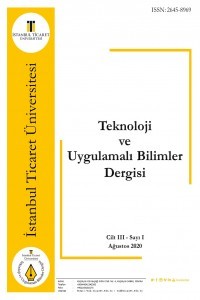AKILLI ŞEHİRLERDE BELİRLİ VERİ SETLERİ İÇİN MEKÂNSAL ARAMA ALGORİTMALARININ PERFORMANS KARŞILAŞTIRILMASI
Akıllı Şehirler, Uzamsal Arama, k En Yakın Komşu, Dörtgen Sorgular, r-Ağacı ve kd-Ağacı
PERFORMANCE COMPARISON OF SPATIAL SEARCH ALGORTIHMS FOR SPECIFIC DATASETS IN SMART CITIES
___
- Cover, T., Hart, P. (1967). Nearest neighbor pattern classification. IEEE Transactions on Information Theory, 13, 21-27.
- Digital in 2020. We are Social, https://wearesocial.com/digital-2020 Guttman, A. (1984). R Trees: A Dynamic Index Structure for Spatial Searching. Sigmod Record, 14, 47-57. Hou, W., Li, D., Xu, C., Zhang, H., Li, T. (2019). An Advanced k Nearest Neighbor Classification Algorithm Based on KD-tree. 2018 IEEE International Conference of Safety Produce Informatization (IICSPI), 10-12 Dec. 2018, Chongqing, China.
- Hu, L., Huang, M., Ke, S., Tsai, C. (2016). The distance function effect on k-nearest neighbor classification for medical datasets. SpringerPlus, 5, 1304.
- Li, G., Tang, J. (2010). A New K-NN Query Algorithm Based on the Traversal and Search of the Dynamic Rectangle. 2010 International Conference on E-Product E-Service and E-Entertainment, 7-9 Nov. 2010, Henan, China.
- Liu D, Lim E, Ng W. (2002). Efficient k nearest neighbor queries on remote spatial databases usingrange estimation. In: Proceedings of international conf. on scientific and statistical databasesmanagement (SSDMB), 2426 July 2002, pp 121–130, Edinburgh.
- Oliphant, T. E. (2007). Python for Scientific Computing. Computing in Science & Engineering, 9, 10-20. Zhang, S., Li, X., Zong, M., Zhu, X., Wang, R. (2017). Efficient kNN Classification With Different Numbers of Nearest Neighbors. IEEE Transactions on Neural Networks and Learning Systems, 29, 1774-1785.
- Zhang, Z., Zhang, J., Yang, J., Yang, Y. (2007). A New Approach to Creating Spatial Index with R-Tree. 2007 International Conference on Machine Learning and Cybernetics, 19-22 Aug. 2007, Hong Kong, China.
- Zhu, Q., Gong, J., Zhang, Y. (2007). An efficient 3D R-tree spatial index method for virtual geographic environments. ISPRS Journal of Photogrammetry and Remote Sensing, 62, 217-224.
- Yayın Aralığı: Yılda 2 Sayı
- Başlangıç: 2018
- Yayıncı: İstanbul Ticaret Üniversitesi
İNSANSIZ HAVA ARAÇLARININ HAREKET VE YÖNLENDİRME PROTOKOLLERİNE GÖRE PERFORMANS ÖLÇÜMÜ
Nurullah Onurhan YALÇIN, Ali BOYACI
YAKIN ÇEVRE KULLANICILARININ GALATAPORT PROJESİ’NDEN BEKLENTİLERİ
Muhammet AKTAŞ, Elif Kısar KORAMAZ
SUPPLIEREVALUATION ANDSELECTION FORA CONSTRUCTIONCOMPANY
Ibrahim Mohamed AHMED, Berk AYVAZ
RAYLI SİSTEM ARAÇLARININ YERLİLEŞTİRİLMESİ
PLANSIZ GELİŞMİŞ KONUT ALANLARINDA 6306 SAYILI KANUN’UN UYGULANIŞI: SULTANBEYLİ ÖRNEĞİ
Tuncay AKÇAY, Elif Kısar KORAMAZ
HAVACILIKTA OPERASYONEL AKSAKLIK MALİYETLERİNİN MOORA YÖNTEMİYLE İNCELENMESİ
Orhan Tayfun YILDIZ, Özlem DENİZ
Adil Hani ABDULKAREEM, Mustafa Cem KASAPBAŞI
ENGELLİLERİN KENT İÇİNDEKİ MOBİLİTESİ: KADIKÖY VE ÜSKÜDAR İLÇELERİNDE ERİŞİLEBİLİRLİK ÇALIŞMALARI
Abdulkadir DİCLE, Tuncer TOPRAK
ENDÜSTRİ MİRASININ YENİDEN İŞLEVLENDİRİLMESİ VE LONDRA COAL DROPS YARD ALIŞVERİŞ MERKEZİ ÖRNEĞİ
